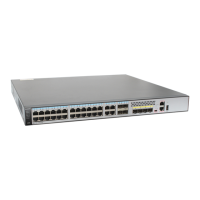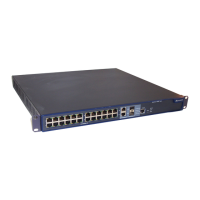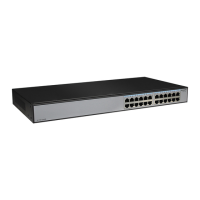Command Manual – STP
Quidway S8500 Series Routing Switches Chapter 1
MSTP Configuration Commands
Huawei Technologies Proprietary
1-5
Description
Use the display stp command to view the state information and statistics information
of the spanning tree.
The MSTP state and statistics information can help analyze and maintain the network
topology and maintain the normal operation of MSTP.
If no spanning tree instance ID or port list is specified, the command will display the
spanning tree information of all the instances on all the ports in port number order. If the
instance ID is specified, the command will display the spanning tree information of the
specified instance on all the port in port number order. If only the port list is specified,
the command will display the information about all the MSTIs on the port in port number
order. If both instance ID and port list are specified, the command will display the
spanning tree information of the specified instance and port according to the port list of
the instance ID.
If there is an aggregation port, the command will only display the instance information
on the master port.
MSTP state information includes:
1) Global CIST parameter: Protocol operation mode, switch priority in the CIST
instance, MAC address, Hello Time, Max Age, Forward Delay, Max Hops, CIST
common root, external path cost of the switch to the CIST common root, region
root, internal path cost of the switch to the region root, CIST root port of the switch,
and whether to enable BPDU protection; Number of received TC/TCN packets,
time interval for receiving packets. If you specify the relationship between a master
root and one or multiple slave roots, the global CIST parameters can also be
displayed in CIST Root Type.
2) CIST port parameter: Port state, role, priority, path cost, path cost standard
designated bridge, designated port, edge port/non-edge port, whether connected
to the point-to-point link, port transit limit, whether to enable Root protection,
whether being a region edge port, Hello Time, Max Age, Forward Delay,
Message-age time, and Remaining-hops; Num of VLANs Mapped, number of sent
BPDU packets, and number of received BPDU packets.
3) Global MSTIs parameter: MSTI instance ID, bridge priority of the instance, region
root, internal path cost, MSTI root port, MASTER bridge, path cost to region root
and number of the received TC packets. If you specify the relationship between
master roots and slave roots in an instance, the global MSTI parameters can also
be displayed in MSTI Root Type.
4) MSTIs port parameter: Port state, role, priority, path cost, path cost standard,
designated bridge, designated port, and remaining hops. You can view Num of
VLANs Mapped in port view.
Statistics information: Count of TCN, CONFIG BPDU, RST, and MST BPDU
transmitted/received via the port.

